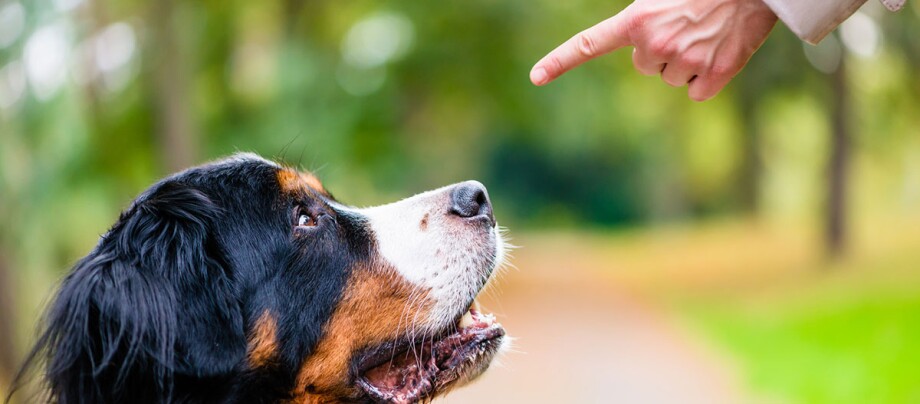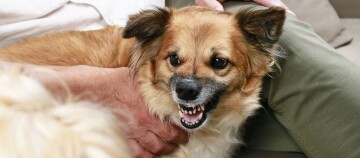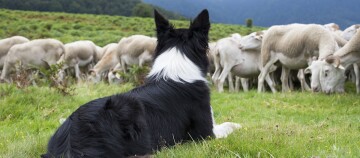What Jumping Up Means for Dogs and How You Can Teach Your Dog to Stop
07.10.2022 - Reading time: 5 minutes

Does your dog always welcome you home by jumping up? Or have other dogs “got in your face” unwanted? In this guide you will find out what jumping up means for dogs and how you can teach your dog to stop.
What is jumping actually for?
Like every type of behaviour of our four-legged friends, jumping up has a meaning. Jumping up is a habit that forms when dogs are just young puppies. For example, a puppy jumps up to its mother and other adult dogs in order to get attention. The puppy intensively licks the adult dog’s flews while doing so.
Adult animals also joyfully lick the flews as a sign of welcome and a gesture of peace. And they do not differentiate between human and dog. It is just that our face – except on children – is too high to be directly reached. So dogs jump up at humans and try to lick their face.
Jumping up can also be observed among younger dogs, who are playfully trying out their strengths and hierarchies and want to make themselves bigger by jumping. Do you should pay attention: These games can also turn into serious fights for dominance. And finally there are also protective dogs that jump up in order to position their quarry or attack an enemy. You have to take this behaviour into account especially if you have a large, dominant dog – and directly train it to stop this behaviour. If you are not sure, an experienced dog trainer can quickly spot the difference between a friendly welcome and disrespectful dominance.
Some dogs also jump up in particular if they are very excited and nervous and do not know what to do with themselves.
This excited jumping is not a sign of aggression.
Excited jumping is not everyone’s cup of tea. Well-meaning welcoming and submission rituals can also end badly if the welcomed person feels overwhelmed. A older person or children can be easily knocked over by a larger dog and can become injured as a result. Children that are not used to dogs may get so scared that they possibly develop a permanent fear of dogs. And muddy paws can instantly ruin an expensive outfit, which could cause the wearer to sue the dog owner.
In other words: When a dog jumps up onto someone, it is part of their nature but you should not tolerate it.
Teaching your dog not to jump up
You should prevent jumping up as early as possible; however, this is particularly important in puppies and younger dogs. The youngster will no doubt also try to express both its excitement and its impatience to you by jumping up and at you. This is how it tries to get you to play or throw a ball for it.
For puppies, it is usually enough simply to ignore this behaviour. However, their cuteness often means that the person the dog is jumping up at gives out positive signals: They bend down, stroke or pat the dog and speak in a high voice. Of course, this is not ideal for ending the jumping.
The aim of the following signals is to make it clear to your dog that jumping up will lead to it being ignored.
- Turn away from your dog without saying a word
- Wait until your dog has stopped jumping up before playing/feeding/rewarding/greeting them.
- In this situation, do not look at your dog. No eye contact, no touching and – very importantly – no talking.
- In your dog’s excited state, even “Stop” or “No” can be motivation for your dog to jump up.
Do not forget: Offer alternatives in order to end the exercises positively
This behaviour, which is correct in and of itself, could have a negative impact on the bond between you and your young dog or puppy, especially if it is too rough. After all, it is very important to your dog that you like it. As a result, it is equally important to work out alternatives.
How do I train my dog not to jump up if it is already an adult?
Teaching a mature dog not to jump up is somewhat more time-consuming and demands consistent conduct and absolute calmness from you. Because you have to overcome long-practised behaviours on both sides – by you and by your dog. If the adult dog jumps up, this action can mean appeasement, dominance, loutish behaviour or it may be a remnant of puppy life.
If the dog races towards you or a visitor, stop it moving with the command “sit” so that it sits down, or call it back. To start with, the lead can be used as support in order to interrupt the impulse before the dog gets up on its hind legs. This can prevent your dog from jumping up.
Your adult dog already knows the commands “No” or “Stop” and can associate them with a prohibition. Try to use these commands and add emphasis by, for example, holding your dog’s front legs or paws and moving them down to the ground. When your dog has calmed down or even sat down, give it an appropriate reward.
It is also helpful not to give your dog any space. Never move back, not even with your upper body. Walk towards your dog, force it backwards. You can even take it by the paws and make it walk a few paces backwards on its hind legs. This is very uncomfortable for most dogs and it will stop jumping up entirely after just a few attempts.
Is jumping allowed when playing?
Every dog owner has to answer this for themselves. Some dog trainers say one thing, some another. It is important to consider the following:
- Can I stop my dog at any time and end the game?
- Does the dog jump up, gnaw etc. reservedly or “at full speed”?
If you can call your dog at any time, end the game and therefore also end the snapping and jumping, then these behaviours can be allowed when playing. Dogs are certainly able to separate the two! Of course they should not throw themselves at you at full speed – the playful character must be retained. If not, you should simply not let your four-legged friend jump up. This also applies if you simply do not like being jumped up at. You can and should set your own rules and apply them consistently.


